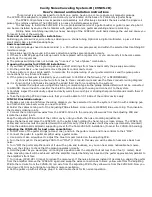
SA-3052A
Owner’s Manual
6-5
®
Operating level, headroom, and signal-to-noise ratio
Somewhere between the noise and peak clipping is the normal operating level of a
device. Looking at this relationship graphically (Figure 6.3), the distance (difference)
between operating noise floor is known as the working signal-to-noise ratio. Finally, the
distance between peak clipping and the noise floor is known as the dynamic range.
Figure 6.3 The relationship between operating level, clipping and the noise floor.
As you can see, the operating level chosen for any given device has a pretty direct
effect on the working signal-to-noise ratio. Pick a level that is too high and you get
premature peak clipping (but spectacular noise performance). Pick a level that is too low
and you have lots of headroom, but a poor working signal-to-noise ratio. Let’s put some
numbers on this: a hypothetical unit, with a -70 dB noise floor, and a +10 dB clipping
level.
Right off, you can see that there is a maximum dynamic range of 80 dB (+10 - -
70). Now, let’s explore a few different operating levels. First, we’ll use a -20 dB which
corresponds to a signal level of around 0.1 volt (a normal listening level on many source
units). At -20 dB, the working signal-to-noise ratio is 50 dB (-70 - -20), which is okay,
but not spectacular. At this same level, we have 30 dB of headroom (+10 - -20).
Now let’s push the operating level up to -10 dB, about 0.3 volt. See if you can do
the math yourself. The working signal-to-noise ratio is 60 dB and we have 20 dB of
headroom. As you can see, there is always a trade-off between signal-to-noise and head-
room. For our make-believe unit, this would be a good level to operate it at.
Some manufacturers specify the dynamic range as the signal-to-noise ratio. For the
unwary person who only looks at numbers without really understanding them, this gives a
truly spectacular number . Only under the most optimistic of operating conditions could
the dynamic range of a device be construed as the signal-to-noise ratio. The condition
under which this is true is where the headroom remaining is precisely zero dB.
The optimum operating level is a compromise between headroom and working
signal-to-noise (s/n) ratio. For most systems, 60 to 80 dB of working s/n is adequate and
practical. Likewise, operating level for each component in the system allows you to set
the working signal-to-noise ratio/headroom trade-off.
Chapter 6 - Getting the Last ¼ dB
Содержание SA-3052A
Страница 2: ...SA 3052A Owner s Manual ...
Страница 4: ...SA 3052A Owner s Manual ...
Страница 30: ...SA 3052A Owner s Manual 5 4 ...
Страница 50: ...SA 3052A Owner s Manual 7 6 ...
Страница 58: ...SA 3052A Owner s Manual 8 8 ...
















































